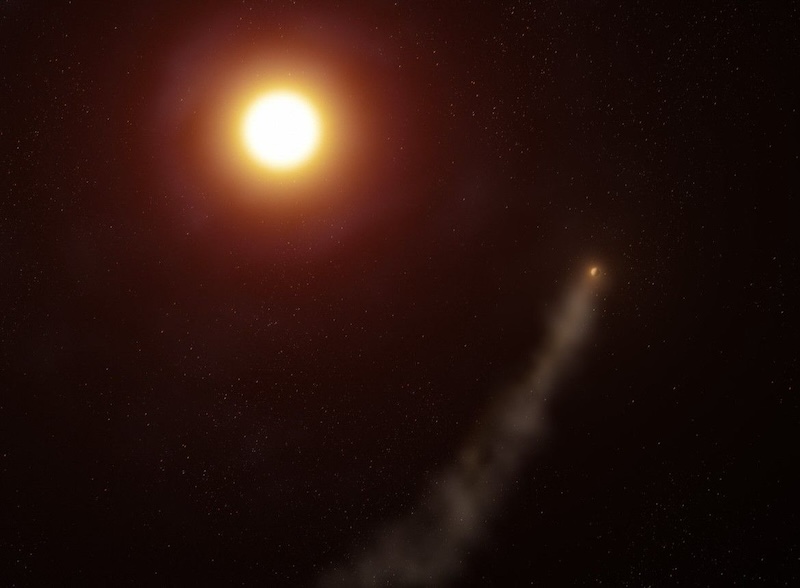An exoplanet with a tail: Artist’s video rendering of WASP-69b orbiting its star, with a tail of gas 350,000 miles (560,000 km) long flowing behind the planet. Intense radiation from the star is stripping some of the atmosphere off the planet. Video via Adam Makarenko/ W. M. Keck Observatory/ UCLA.
We don’t usually think of planets as having tails, like comets, but sometimes they do. Earlier this month, researchers at the University of California, Los Angeles (UCLA), said they found that the giant hot Jupiter exoplanet WASP-69b has a tail of gas much longer than previously estimated. The comet-like tail is 350,000 miles (560,000 km) long, seven times as long as the planet is wide. The tail is the result of its parent star burning off the planet’s atmosphere. The scientists said this confirmation of an exoplanet with a tail will help them better understand how physics shapes planets and how planets evolve.
The research team published their peer-reviewed findings in a new paper in The Astrophysical Journal on January 9, 2024.
Meet WASP-69b
WASP-69b is a gas giant planet about the same size as Jupiter. WASP-69b is 160 light-years from Earth. But unlike Jupiter, this planet is a scorching hot world. In fact, it’s what astronomers call a hot Jupiter. It orbits so close to its star that its atmosphere is searing and inhospitable. Mercury orbits the sun every 88 days. But WASP-69b completes an orbit in less than four days.
It’s close enough to its star that the radiation from the star is stripping away the atmosphere.
A giant exoplanet with a tail
The researchers discovered that as the exoplanet’s atmosphere escapes into space, the solar wind from the star – much like our own sun’s solar wind – modifies it into a comet-like tail. The researchers used the 10-meter telescope and its spectrograph called NIRSPEC at the W. M. Keck Observatory in Hawaii for the new study.
Scientists had previously suspected the planet has a tail about 106,000 miles (170,000 km) long. But the new findings show it more than three times larger, about 350,000 miles (560,000 km) long. For the earlier observations, astronomers had used the 3.5-meter (140 inches) telescope at the Calar Alto Observatory in Spain and a 5-meter (200 inches) telescope at the Palomar Observatory in San Diego County. Lead author Dakotah Tyler at UCLA said:
Work by previous groups showed that this planet was losing some of its atmosphere and suggested a subtle tail or perhaps none at all. However, we have now definitively detected this tail and shown it to be at least seven times longer than the planet itself.
Studying atmospheric loss in real time
The findings will help astronomers learn more about how stellar winds affect planets in other planetary systems. As co-author Erik Petigura at UCLA explained:
Over the last decade, we have learned that the majority of stars host a planet that orbits them closer than Mercury orbits our sun and that the erosion of their atmospheres plays a key role in explaining the types of planets we see today. However, for most known exoplanets, we suspect that the period of atmospheric loss concluded long ago. The WASP-69b system is a gem because we have a rare opportunity to study atmospheric mass-loss in real time and understand the critical physics that shape thousands of other planets.

A tail of hydrogen and helium
The tail is composed mostly of hydrogen and helium. The stellar winds push and shape the gases into the tail-like appearance. Petigura said:
These comet-like tails are really valuable because they form when the escaping atmosphere of the planet rams into the stellar wind, which causes the gas to be swept back. Observing such an extended tail allows us to study these interactions in great detail.
Even though the planet is losing some of its atmosphere, the researchers said it won’t lose all of it. According to Tyler:
At around 90 times the mass of Earth, WASP-69b has such a large reservoir of material that even losing this enormous amount of mass won’t affect it much over the course of its life. It’s in no danger of losing its entire atmosphere within the star’s lifetime.
The resilience of this planet in such an extreme and hostile environment serves as a powerful reminder to us all. Despite the multitude of challenges we may face, our capacity to withstand and overcome is often far greater than we realize. Our problems may seem daunting, but like WASP-69b, we have what it takes to continue on.
Another exoplanet with a tail
In 2015, astronomers reported that the Neptune-sized exoplanet Gliese 436b also has a comet-like tail, composed of hydrogen. That planet is 33 light-years away, and the tail is about 50 times longer than the width of the host star!
And did you know? In our own solar system, Mercury has a long sodium tail. Sunlight and micrometeorites blast sodium atoms off Mercury’s surface. The tail is tenuous, but also long, about 100 times the diameter of Earth.
Bottom line: Researchers at UCLA have found an exoplanet with a tail. The hot Jupiter WASP-69b has a huge comet-like tail of gas 350,000 miles (560,000 km) long.
Source: WASP-69b’s Escaping Envelope Is Confined to a Tail Extending at Least 7 Rp
Read more: Exoplanet has a comet-like tail Gliese 436b
Read more: See Mercury’s sodium tail in specially filtered photographs











